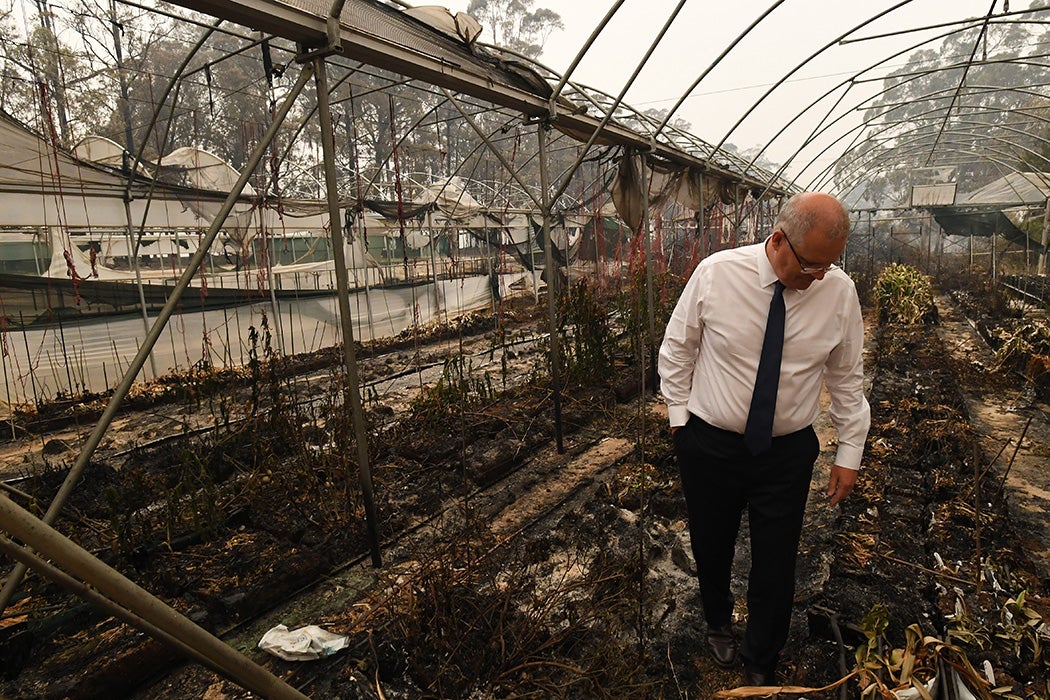It’s a grim start to the new year. The world has only lately become aware of the many bush fires still raging out of control in Australia—particularly severely in my home state of New South Wales—though they’ve been burning throughout the land since September of last year.
Australia is a large country, about the same size as the United States. The devastation from the fires has now covered more than 10 million hectares, an area twice the size of Belgium and far bigger than the combined fires in the Amazon and California, which so recently shocked the world.
Weekly Newsletter
Australia is also a small country. This has become important too, for different reasons. With such a small population, it’s hard not to know a person or place that hasn’t been affected: the loss and the grief is starkly local, not something happening on the other side of the world. An estimated billion—a billion—native animals have died, burned or suffocated; some twenty-eight people have lost their lives fighting for their homes, fighting for the land, or just by breathing in the polluted, smoke-thickened air, what’s left of the trees. On the first day of this new year, the world’s most hazardous air quality was recorded in the nation’s capital of Canberra, a wealthy city in a wealthy nation. Eventually, when the desired rains come, the rain will wash away toxic debris and ash into the waterways, another ecological disaster. Scientists are concerned that the land’s ability to regenerate, recover and re-absorb the carbon released by the fires will be profoundly affected.
It is, many people worry, a harbinger of the climate-induced crises yet to come, that will come, to many other wealthy, apparently safe, presently oblivious developed countries of the world, if we don’t heed the warnings that Australia’s state of emergency has abruptly confronted us with.
While our sunburned country is no stranger to fire, this is unprecedented. And yet it had been solidly forecast by experts. But the early warning pleas of official reports, from senior emergency leaders, fire chiefs, scientists and researchers, were roundly ignored by Australia’s Liberal (that is, conservative) government in power, led by Prime Minister Scott Morrison. It’s shocking to think that the worst of this crisis could well have been avoided had the Morrison government taken these warnings seriously.
But if there’s one thing more horrifying than the real stories on the ground of people and animals trapped in burning environments, it perhaps has been to see, unfolding in real time, the plausible yet false digital hoaxes that have spread just as quickly as the wildfires, doing just as much damage.
This is a less obvious, more insidious threat. It’s one of language weaponized, of deliberate disinformation couched in ordinary terms designed to stoke our fears. Different vested interests have manipulated language to downplay, deflect, and shift public attention away from blaming political leaders for ignoring the clear scientific consensus behind the climate emergency. But has it worked?
Morrison’s astonishingly clumsy spinning of the crisis has, in fact, ignited a political firestorm and led to a public and international outpouring of blame. This, in turn, has clarified the open use of discourse and information manipulation, all of which have supported the ideological narrative of minimizing the climate crisis.
In the words of sci-fi great Philip K. Dick, “The basic tool for the manipulation of reality is the manipulation of words. If you can control the meaning of words, you can control the people who must use the words.” Indeed, recent research has explored how storytelling can be a powerful source of manipulation exploited by leaders. Controlling the narrative allows leaders to connect with people on some common ground or to exploit social vulnerabilities; the targets aren’t fully certain that they’re being misled or that power is even being exerted. But this strategy can backfire if the ruse is discovered.
Morrison’s former career was in marketing, perhaps accounting for his propensity to use obvious PR techniques to wriggle out of blame. This has led many of his detractors to mock him with the hashtag #Scottyfrommarketing, showing how skeptical many Australians have become about his intentions and authenticity. From three-word slogans such as the divisive “Stop the Boats” campaign to a heavily branded campaign tour bus that traveled empty from town to town as Morrison traveled by air, the prime minster has become renowned for his devotion to the slippery language of spin, as he dismisses respected international reports ranking Australia last in climate policy as “not credible” without explaining why. When asked what he intends to do about a problem, he often uses language that deflects the question by stating what he won’t do: “What we won’t do is engage in reckless and job-destroying and economy-crunching targets,” for example, framing further climate action as negligent without any debate.

Sten Hansson’s linguistic case study on blame avoidance in government lays out the many ways that political leaders have sought to reframe scandals and political firestorms to escape accountability. With weak leadership, there’s a vested interest in avoiding blame, so governments might use any number of empty rhetorical tricks to mitigate the perception of loss (such as minimizing the severity of a bush fire crisis, or framing it as normal and nothing to worry about), and shift the responsibility to someone else (such as blaming other state government leadership).
Hansson shows that in blame discourse like this, governments frequently frame the political narrative to depict themselves as heroes, or sometimes victims, that face formidable foes. Morrison consistently paints himself as a kind of “daggy dad” of the nation, setting up expectations of care and empathy he cannot meet. Political leaders can use a “discursive power abuse” through language to manipulate communication and public perception. Leaders can deflect attention by appealing to cultural common ground, the way Morrison constantly mentions cricket matches to change the subject from the bush fire crisis. Another way to avoid blame is to reinforce domination over the less powerful, just as Morrison claims that state leaders refused or had never asked for help. Leaders can also manipulate short term memory to bias the public’s understanding of recent information, as with Morrison’s provably false claims that he has always acknowledged a link between fires and climate change yet saying “it’s just absurd” to think that any specific fire event can be linked to climate change. Leaders can also encourage the polarization of groups to block specific information from being accepted, such as Morrison’s allowing his supporters to spread the easily debunked hoax that Australia’s Green party, which has never been in government and therefore cannot enact policy, is to blame.
Even under international scrutiny, Morrison’s manipulative marketing strategies have run the gamut. Despite being continuously informed of the severity of the fires, he left for an ill-timed Hawaiian holiday, and his office lied about his whereabouts. He initially demurred about paying the majority-volunteer firefighting force, saying that “they want to be there.” Upon his return, he visited small towns that had been severely affected by the fires for blatant photo opportunities, wringing reluctant handshakes from angry townspeople but bringing little in the way of material support.
At the height of national anger against his lack of leadership, Morrison released a political ad, complete with jingle, taking credit for other people’s achievements. Horrifyingly, the ad included a link that aped those of fundraising campaigns for the rural fire service or victims of the fires, but actually linked to his own political party.
What can be said about Morrison’s marketing spin? In “A Framework for Assessing Immorally Manipulative Marketing Tactics,” Shlomo Sher investigates the question of when marketing tactics cross the line into immoral or unethical manipulation. Some would argue that all marketing is inherently manipulative, and all manipulation is, at its heart, deceptive, to persuade consumers to make decisions they might not normally make. We tend to view the discourse of manipulation with the assumption that the consumer is hapless, ready to fall into any clever linguistic trap, but perhaps we should direct our attention to the marketers’ real intentions, which are often more complex. Even if marketers aren’t aware of their intentions in using some persuasive approaches, they may be morally blameworthy for omitting or misrepresenting facts and information. If a dating website deceptively inflates the number of its users through fake accounts, is that an immoral practice? Are a corporation’s paid influencers masquerading as regular customers? What if a politician pays for thousands of fake social media followers to suggest support for policies, or funds a campaign to spread disinformation using bots?
Morrison’s heavy-handed marketing approach, on which he’s come to depend, has come at the cost of public trust—it has become all too obvious, in part because of the support he’s received from two other sources of disinformation.
One is the deceptive suppression and omission of information by Newscorp media sources. Influential Rupert Murdoch-owned Australian news publications have buried the bush fire disaster in back pages while featuring lock-step support of the current government in the front pages. In comparison to every other major international publication’s treatment of the crisis as serious and newsworthy, Newscorp’s early omissions and obfuscations have been so plain to see, they’ve been spotlighted by peers such as The New York Times and The Guardian, and criticized by some Murdoch family members as suggesting a concerted campaign of news manipulation.
Lastly, bot networks, funded by some unknown source, have been detected. They have sought to influence public opinion by disseminating fake news about Australia’s bush fire crisis. Researchers, such as Dr. Timothy Graham, who have worked on uncovering these bot disinformation networks, have found sudden overwhelming activity of marginal or automated social media accounts clustering around certain partisan language and hoax hashtags: #arsonemergency, for example. False statistics and fake news blaming arsonists for the bush fire were broadcast by Newcorp media and promoted by ideologically aligned social media influencers, including Donald Trump Jr. Thanks to these influences, the media in Australia have been relatively subdued, almost tentative, often blindly accepting government talking points. It has taken attention from more international publications to hold political leaders to account.
The disinformation has been rife, but it has also been all too sudden and unsubtle. If the protests calling for the prime minister to resign or the recent polls showing a severe and abrupt drop in the PM’s approval rating are anything to go by, it seems Australians have not been fooled by this disinformation—except those who are predisposed to believing the propaganda. Australians are angry, rightfully so, at the needless deaths and destruction of homes, of whole towns and forests. It’s easy to be angry when the manipulative language of marketing spin to sell unpalatable ideas in the face of this reality is so explicit.
Perhaps the fight against disinformation lies in the relatively strong networked ties that a smaller nation like Australia can still strive to maintain. Sociologist Mark S. Granovetter found that information can spread far and wide along weak and marginal ties in a network, but when a group has multiple and strong ties among its members, misinformation such as rumors can be suppressed at many points and die before they spread too far. Along with multiple feedback sources on the ground, with trusted community leaders such as fire emergency commissioners and the police steadfastly correcting the disinformation that suddenly arises, it seems to have been harder for deliberate hoaxes to have as widespread an influence on changing Australian minds.
This is a time, if ever there was one, for true leadership, for a visionary language that galvanizes a community, local and global, into collective action, in the face of collective grief. It shows that an empty, empathy-less disinformation and misdirection campaign does not always have to take root in a community but can be countered before it rots from within, by maintaining the strong ties we have to our communities by talking to each other and by sharing what we know of the truth.







